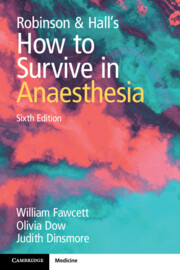
- Publisher:
- Cambridge University Press
- Online publication date:
- June 2025
- Print publication year:
- 2025
- Online ISBN:
- 9781009421294

The initial months working as a trainee anaesthetist are daunting, with a wealth of new drugs, terminology, anaesthetic equipment, and practical procedures to master. This essential guide, now in its sixth edition, provides doctors and clinical staff with a clear introduction on the delivery of safe anaesthesia from day one. Fully updated and split into four key parts for quick consultation, it covers the airway and anaesthetic equipment, and offers advice on how to manage common crises and emergencies such as cardiac arrest, haemorrhage, and blood transfusion. Proceeding parts explore subspecialties and provide information on intensive care and perioperative medicine. Thoroughly revised and updated to reflect recent changes in anaesthesia, and including new chapters on obstetric anaesthesia, common regional nerve blocks, and emergency laparotomy. Written in an accessible style, it is an essential resource for learning the safe fundamentals of anaesthetic practice for trainee anaesthetists and clinical staff working alongside anaesthetists.
 Loading metrics...
Loading metrics...
* Views captured on Cambridge Core between #date#. This data will be updated every 24 hours.
Usage data cannot currently be displayed.
The PDF of this book is known to have missing or limited accessibility features. We may be reviewing its accessibility for future improvement, but final compliance is not yet assured and may be subject to legal exceptions. If you have any questions, please contact accessibility@cambridge.org.
Allows you to navigate directly to chapters, sections, or non‐text items through a linked table of contents, reducing the need for extensive scrolling.
Provides an interactive index, letting you go straight to where a term or subject appears in the text without manual searching.
You will encounter all content (including footnotes, captions, etc.) in a clear, sequential flow, making it easier to follow with assistive tools like screen readers.
You will still understand key ideas or prompts without relying solely on colour, which is especially helpful if you have colour vision deficiencies.
You gain clarity from ARIA (Accessible Rich Internet Applications) roles and attributes, as they help assistive technologies interpret how each part of the content functions.